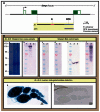Investigation of dmyc Promoter and Regulatory Regions
- PMID: 23761963
- PMCID: PMC3663572
- DOI: 10.4137/GRSB.S10751
Investigation of dmyc Promoter and Regulatory Regions
Abstract
Products of the myc gene family integrate extracellular signals by modulating a wide range of their targets involved in cellular biogenesis and metabolism; the purpose of this integration is to regulate cell death, proliferation, and differentiation. However, understanding the regulation of myc at the transcription level remains a challenge. We performed rapid amplification of dmyc cDNA ends (5' RACE) and mapped the transcription start site at P1 promoter, 18 base pairs upstream of the start of the known EST GM01143 and within the 5' UTR. Our data show that the first TATA box, previously computationally predicted, is utilized to generate dmyc full length mRNA. The largest transcript contains all three exons, generated after the removal of the introns by constitutively regulated splicing events. Further investigation of Downstream Promoter Element (DPE) was achieved by studying lacZ reporter activity; investigation revealed that this element and its upstream cluster of binding sites are required for the dmyc intron 2 activity. These findings may provide valuable tools for further analysis of dmyc cis-elements.
Keywords: 5′ RACE; Downstream Promoter Element (DPE); Drosophila; RNA splicing; TATA-box; dmyc.
Figures








Similar articles
-
Identification of cis-Regulatory Elements in the dmyc Gene of Drosophila Melanogaster.Gene Regul Syst Bio. 2012;6:15-42. doi: 10.4137/GRSB.S8044. Epub 2011 Dec 21. Gene Regul Syst Bio. 2012. PMID: 22267917 Free PMC article.
-
Drosophila TFIID binds to a conserved downstream basal promoter element that is present in many TATA-box-deficient promoters.Genes Dev. 1996 Mar 15;10(6):711-24. doi: 10.1101/gad.10.6.711. Genes Dev. 1996. PMID: 8598298
-
Whole-genome analysis reveals a strong positional bias of conserved dMyc-dependent E-boxes.Mol Cell Biol. 2005 May;25(9):3401-10. doi: 10.1128/MCB.25.9.3401-3410.2005. Mol Cell Biol. 2005. PMID: 15831447 Free PMC article.
-
The DPE, a core promoter element for transcription by RNA polymerase II.Exp Mol Med. 2002 Sep 30;34(4):259-64. doi: 10.1038/emm.2002.36. Exp Mol Med. 2002. PMID: 12515390 Review.
-
Structure and regulation of the luteinizing hormone receptor gene.J Steroid Biochem Mol Biol. 1995 Jun;53(1-6):283-91. doi: 10.1016/0960-0760(95)00115-g. J Steroid Biochem Mol Biol. 1995. PMID: 7626469 Review.
Cited by
-
Characterization of putative cis-regulatory elements in genes preferentially expressed in Arabidopsis male meiocytes.Biomed Res Int. 2014;2014:708364. doi: 10.1155/2014/708364. Epub 2014 Aug 27. Biomed Res Int. 2014. PMID: 25250331 Free PMC article.
References
LinkOut - more resources
Full Text Sources
Other Literature Sources
Molecular Biology Databases
Research Materials

